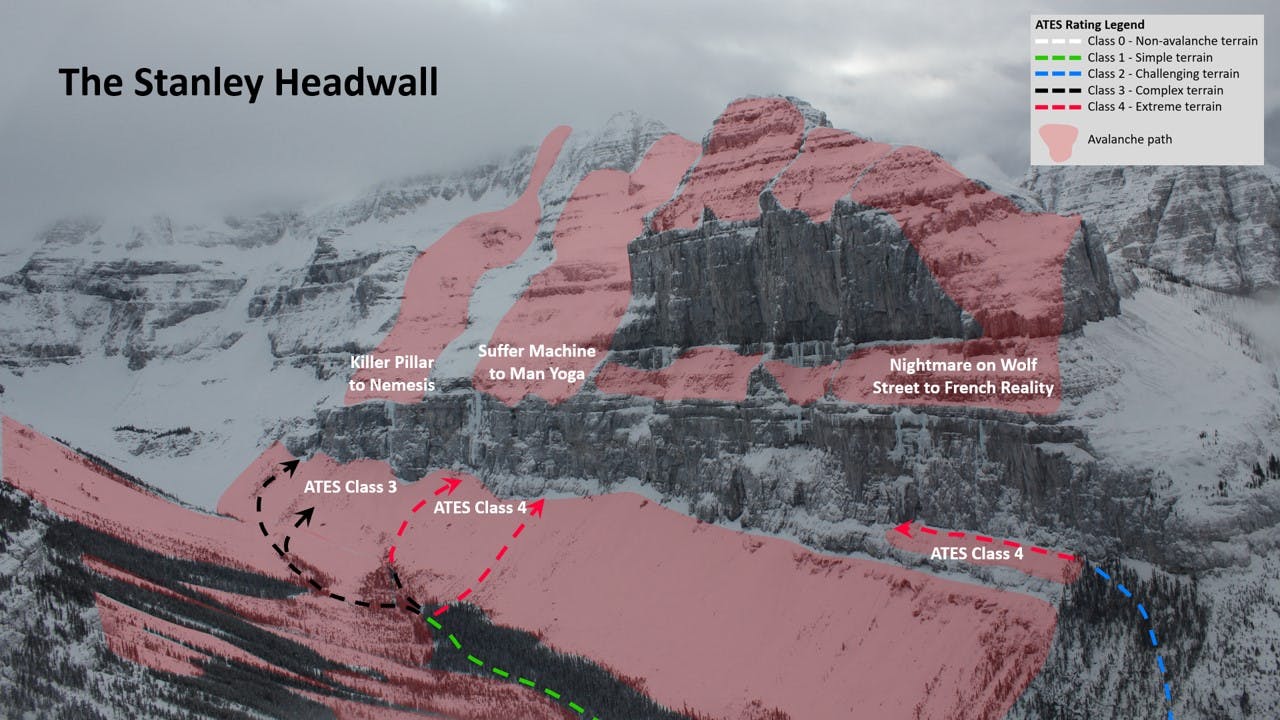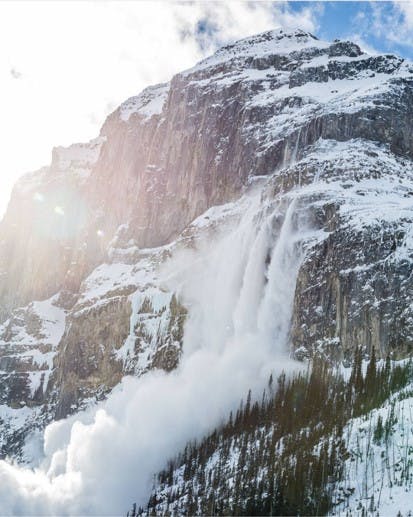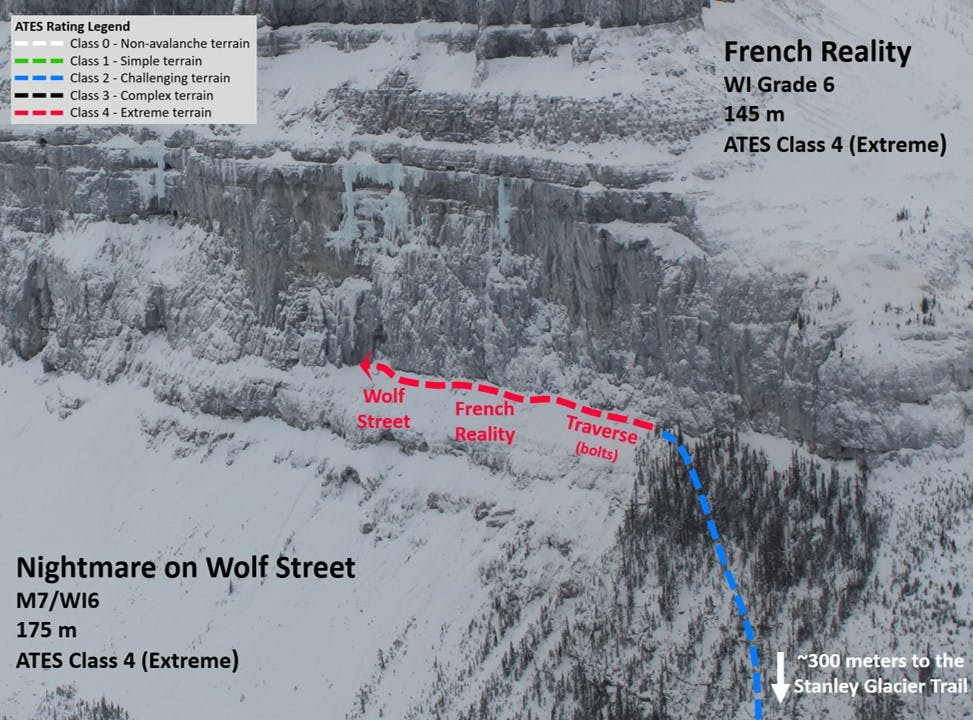
An overview of the Stanley Headwall.
The Day After les Vacances de Monsieur Hulot - French Reality Sector
268m WI6 M7
ATES 4 (Extreme)
The Stanley Headwall is home to some of the Canadian Rockies' hardest and finest mixed testpieces. Located in Kootenay National Park, it is generally accessed through Banff National Park. The approach to the Stanley Headwall can take 1.5–2 hours, depending on snow conditions, fitness level, and whether you're using skis or snowshoes.
This is the first sector of the drainage. It has a different approach to the other two, and with it an additional hazard of crossing an exposed ledge system.
French Reality and Nightmare on Wolf Street are some of the more popular climbs in this sector. They have also been the scene of some serious close calls with avalanches.
Popularity
- 20 people completed the survey
- 16% climbed it once
- 42% climbed it 2–5 times
- 42% climbed it six or more times
Avalanche frequency
- 21% have never seen any avalanche debris
- 42% have seen avalanche debris less than half the time they climbed the route
- 16% have seen debris more than 50% of the time to always
- 11% have always seen avalanche debris
- 53% have witnessed an avalanche in the area
Runout debris
- 85% of respondents saw avalanche debris on the approach.
- 70% saw debris at the base of the climb or lower

A avalanche on French Reality.
Notes on avalanche debris:
- People saw debris ranging from full path to the valley bottom to sluffs to the base of French Reality.
- This shoulder may get more wind loading than the central and looker's left zones, with occasional trouble getting up to the climbs.
- Most people saw debris in two main places: the approach ledge and below the approach ledge on the fans underneath.
- Several people mentioned seeing debris running into the treed approach area.
- The ledge traverse shows signs of full depth avalanches that would sweep a climber over the cliff.
Trigger
- 80% of respondents said natural
- 20% said human-triggered
Start Zone
- 78% of respondents said it started well above the climb
- 11% said right above the climb
- 11% said human-triggered on the approach
Contributing factors
- 67% of respondents say new snow amounts were a contributing factor
- 89% say winds
- 11% say significant warming
Reported avalanches and incidents
- "Have often seen slides come over the French reality area from afar. Earlier this winter, I had walked up the valley to climb Fiasco then in the afternoon when walking out noticed the ledge below Monsieur Hulot had slid and I could see a noticeable crown line. Debris ran halfway down the slopes below the cliffs and almost to the trees. Not a windy day, but had warmed up from -15 or -20 the day before to -5 or so."
- "Moderate winds over the shoulder formed a spindrift slab at tree line around the gear up cave."
- "I have approached from directly below and bailed due to scary snowpack conditions (whumpfing)."
- "Release from a gully above the approach up the wooded slopes to the ledge traverse. Directly above me. I crouched behind a tree and the snow passed me without incident."
- "Had new snow overnight, 8 to 10 cm at the parking lot. Triggered small slabs underneath us on the approach. We were approaching Nightmare on Wolf Street, when 100 m from the base of the climb, a size 1 to 1.5 avalanche released naturally and covered the route in a puff of snow. We turned around."
- "Topping the last pitch on French Reality, ~size 2 came down about 100 m to the left of the climb. Climbers were on Suffer at the time and said it was about 50-100 m to their right
- "I’ve seen several avalanches in the area. Most commonly is over the Nightmare and French Reality sector, then the Man Yoga area. Both have massive overhead exposure not observed from the trail."

The first sector of the Stanley Headwall drainage.
Other notes and summary
- I think debris can be a bit less obvious here as you traverse above the cliff band, and you might not have as clear a view of the runout slope. I'm sure that I've seen old debris from size 2-3 avalanches that started above the route, although no specific instance comes to mind.
- There is a famous story of some climbers being avalanched while on French Reality. Another talks about debris coming down on him while on Nightmare.
- There are two ways to approach these routes, and both are very serious avalanche terrain. From the bottom you have to walk up a huge slope below the climb, and if you trigger it then you are under it, which is not good. Or, you can easily walk up the treed shoulder below and right of the climbs, then cross the exposed snow ledge below the routes to reach them. This way is also dangerous as it is above cliffs, but at least you can belay across the ledge. I prefer the ledge approach. There is also a huge slope overhead that releases naturally and runs directly over these climbs.
- I have witnessed many large sluffs above the climbs there, and changed the objective several times based on that.
- I’ve heard somewhere that the third pitch is very exposed for having a leader get knocked off by an avalanche. Since the other ones aren’t as exposed, the assumption is that if they released, you'd somehow be missed by it A very interesting and dicey idea.
- I have also had small loose dry slides come down threatening the approach slope when crossing past FR toward the base of the Hulot/Nightmare.
